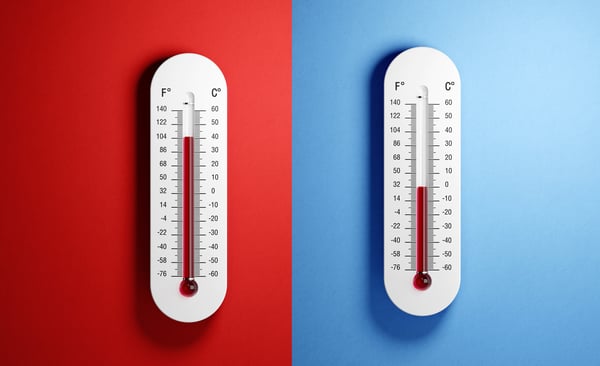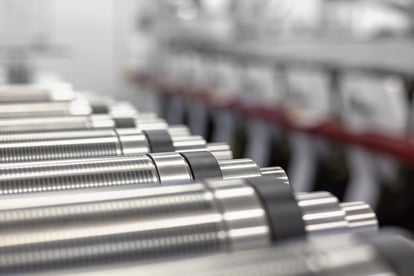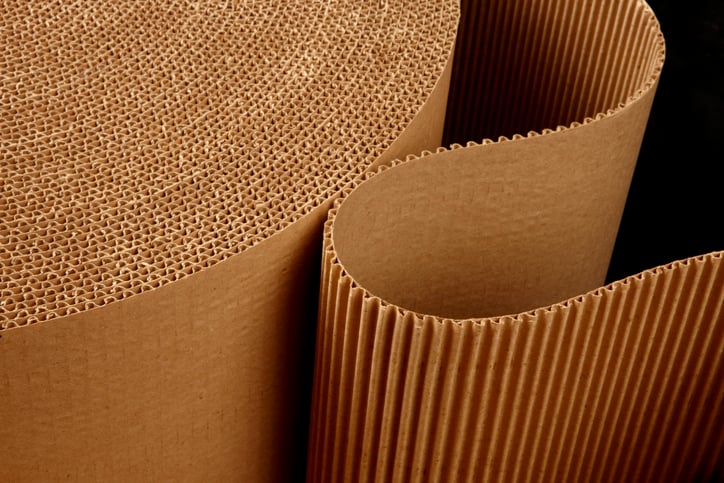Flexo Printing Sleeves and Thermal Contraction & Expansion

As we all know, there are many variables in play when we turn on our flexo printing press. Are our air mandrels aligned? Does our ink have the right surface tension? But, one variable you might not have checked is the temperature.
Pressroom temperature not only affects your ink drying time and employee satisfaction, but it also determines the rate of expansion/contraction of your flexo printing sleeves.
Thermal expansion or contraction can affect plate/sleeve swell, which impacts repeatability. And anything that hinders your repeatability is an enemy.
Keep reading to learn more about thermal contraction and expansion and what you can do to mitigate their effects.
Explaining Thermal Contraction and Expansion
Due to the nature of the elastomer materials used for sleeve production, the rate of expansion or contraction can be roughly calculated at a fractional change per degree of temperature, referred to as the linear coefficient of thermal expansion.
Linear thermal expansion is calculated using the following formula: ΔL = αL x ΔT x L
Where:
- L = initial length
- ΔL = change in length
- αL = coefficient of linear thermal expansion -- approximately 44(10-6 in. [in °F]) for hardened rubber
- ΔT = change in temperature
But, why does thermal contraction and expansion occur?
The polymers used to make flexographic printing sleeves are very sensitive to temperature changes. So much so that a small temperature change could disrupt a whole print. Thermal expansion is a common problem because the flexo printing process is often, well, a hot one.
Thermal expansion and contraction can lead to a slew of problems in the press room, including:
- Misregistration
- Sleeves wearing out faster
- Less-accurate prints
ELASTOMER SLEEVES VS. PHOTOPOLYMER PLATES: THE DEBATE CONTINUES
The flexo printing community knows the argument well: elastomer sleeves or photopolymer plates?
Well, here’s another aspect of the debate -- thermal conductivity.
Photopolymer printing plates and sleeves come with a lower specific heat capacity and, as such, they contract and expand faster than the elastomer options. After all, photopolymer sleeves and plates require less energy to raise their temperatures than their elastomer counterparts.
Elastomer plates and sleeves have thicker walls, and more energy is required to raise their temperatures. By default, 4x the energy is required to raise the temperature of an elastomer by 1° as compared to the polymers used in plates. You’ll also need more time to lower the elastomer sleeves to their original temperatures.
Steps to Reduce the Effects of Thermal Expansion
While it’d be great to have a cure-all for thermal expansion and contraction, it’s not that easy. Reducing the effects of thermal expansion comes with constant monitoring of your sleeves and calculating risk.
Here are some important considerations:
- Sleeve storage
- Press room temperature
- Humidity
- Elastomer sleeve thickness
- Knowing your data
STORAGE
A properly stored sleeve would certainly experience a more uniform expansion rate (and likely a lower rate) than a sleeve that’s leaning up against a wall with its end on a concrete floor.
PRESS ROOM TEMPERATURE
Regulating press room temperature is important, but with our example above it would have little effect. While the air temperature could be 72° F, the floor could easily be 55° F (especially in the winter). This would cause one end of the sleeve to contract, while the other remains within tolerance.
HUMIDITY
Humidity can give the appearance of a thermal issue by causing expansion of the sleeve covering. While allowing the sleeve temperature to stabilize will yield some improvement, if the issue is humidity the defect will only slightly improve.
Say you have a sleeve which is measuring undersize (cold) in a high-humidity environment -- allowing the temperature to stabilize to room temperature (72° F) will cause an expansion of the sleeve material, but in a high-humidity environment, the elastomer will already be expanded. Increasing the temperature will actually cause the sleeve to print "oversized" due to humidity enhanced swelling. This can also lead to the belief that the sleeve is on size prior to temperature stabilization.
ELASTOMER SLEEVE THICKNESS
Sleeve rubber thickness has an effect on the valuation of expansion or contraction. Thicker sleeve covering has a smaller chance of being susceptible to thermal contraction/expansion, while thinner covering might recover more quickly from it.
DATA COLLECTION AND ANALYSIS
As with any process, properly collecting data and analyzing it can shed some light on the thermal expansion/contraction of your sleeves.
Flexo printing plate/sleeve manufacturers compare and contrast the linear and volumetric thermal contraction and expansion rates of the different sleeves, plates, and fiberglass core materials of their sleeves/plates. You should be able to get this information from your manufacturer, and paired with your own data collection, you can take steps to avoid unnecessary thermal-related issues.
Great Sleeves Comin’ in Hot!
Well, hopefully not that hot. But, no matter what kind of sleeve/plate you’re using, work with your manufacturer to get the necessary information to mitigate thermal expansion/contraction-related issues.
To learn more about elastomer sleeves or chat about thermal expansion, reach out! We love a good flexo challenge.



